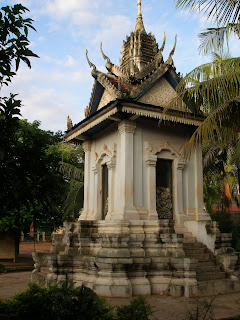 |
| Memorial to those who died in the "killing fields" Pagoda filled with skulls & bones |
Seeing Angkor Wat at sunrise was beautiful and bucolic, such a contrast to the horrors that took place nearby.
There are two buildings called libraries on the grounds of thetemple city
There are two buildings called libraries on the grounds of the
 |
| old libraries held refugees |
 |
| horses graze near a library |
 |
| Memorial Stupa (Pagoda) in Siem Reap |
 |
| faces of those who were exterminated |
Despite this horrifying history, all the Cambodians we have met are extremely friendly. They are very resilient people. You can see evidence of their terrible war in the many landmine victims we have seen at temple grounds or in artisan studios that have been set up for the handicapped.
 |
| poster cautions against placing land mines in fire |
I loved their music and of course, we contributed. I was impressed that these musicians used their talents, instead of begging.
 |
| handicapped father with son |
"Not only do these abominable weapons lie buried in silence and in their millions waiting to kill or maim innocent women and children; but the presence or even the fear of the presence of a single landmine can prevent the cultivation of an entire field, rob a whole village of its livelihood, place yet another obstacle on a country’s road to reconstruction and development"
-- Kofi Annan
 |
| land mine victim orchestra |
"When a war is over I think it's a cowardly thing to leave the war behind you in minefields that hit women and children and the most vulnerable. Imagine the war is finished and you go to work and there are snipers shooting at you. Imagine taking your kids to the beach and you find that the beach is blowing up beneath you. Like there's nowhere safe.That's what I think is insidious about landmines."
-- Paul McCartney
-- Paul McCartney
To read more land mine quotes go to:
http://www.betterworld.net/quotes/landmines-quotes.htm
Sadly, "During their three-year ( 1975-1978) , eight-month, and 21-day rule of Cambodia, the Khmer Rouge committed some of the most heinous crimes in modern history....But if history has proven human beings to be intrinsically fallible, it has also proven us to be extraordinarily resilient. Pol Pot cast a heavy shadow over Cambodia, but the people have managed to persevere, begin anew, and find joy in life again."
From: http://www.vagabonding.com/travelogue/000060.html
Sadly, "During their three-year ( 1975-1978) , eight-month, and 21-day rule of Cambodia, the Khmer Rouge committed some of the most heinous crimes in modern history....But if history has proven human beings to be intrinsically fallible, it has also proven us to be extraordinarily resilient. Pol Pot cast a heavy shadow over Cambodia, but the people have managed to persevere, begin anew, and find joy in life again."
From: http://www.vagabonding.com/travelogue/000060.html

No comments:
Post a Comment